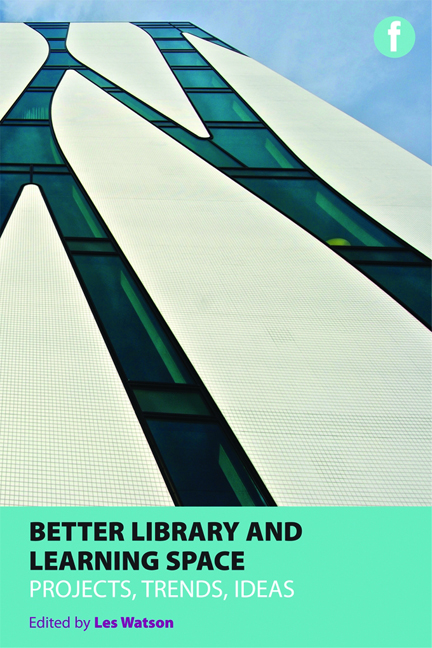Book contents
- Frontmatter
- Contents
- Case studies
- Acknowledgements
- Contributors
- Introduction – about this book
- PART 1 PROJECTS AND TRENDS
- PART 2 TRENDS AND IDEAS
- Introduction
- 7 Library space and technology
- 8 Library space and learning
- 9 Key ideas on space
- 10 Thinking it through
- Summary to Part 2
- PART 3 IDEAS AND FUTURES
- Index
7 - Library space and technology
from PART 2 - TRENDS AND IDEAS
Published online by Cambridge University Press: 08 June 2018
- Frontmatter
- Contents
- Case studies
- Acknowledgements
- Contributors
- Introduction – about this book
- PART 1 PROJECTS AND TRENDS
- PART 2 TRENDS AND IDEAS
- Introduction
- 7 Library space and technology
- 8 Library space and learning
- 9 Key ideas on space
- 10 Thinking it through
- Summary to Part 2
- PART 3 IDEAS AND FUTURES
- Index
Summary
Introduction
Over the years libraries have used technology to improve operational efficiency adopting systems to automate library functions and services that focus on the acquisition, management and circulation of resources, more recently extending these activities, somewhat imperfectly, to digital resources. In contrast to an operational view of IT, this chapter is concerned with the technology of the library in relation to library space. Extensive hardware provision, networking (wired and then wireless) and self-service facilities have been the most noticeable aspects of technology-rich space along with some investment in electronic signage and display screens. The idea of the commons (see Chapter 2), as IT commons and information commons and then learning commons (Watson and Anderson, 2008), has featured the creation of ever larger installations of serried ranks of networked desktop machines, particularly in higher education, reminiscent of battery chicken farms. There is a real threat that such unpleasant environments, increased availability of digital resources, remote access, personal ownership of devices and the inadequate variety of the technology response that is the ‘commons’ will make visiting the physical library become much less likely. Reduced footfall is taken as a key factor in the irrelevance of the library as a place – particularly in public libraries – and an indicator of library ineffectiveness, and adds to the apparent destruction of library as place. So a key question is, Will technology kill the library as a place? For those providing the funding, especially in times of austerity, the technology factor is often a neat excuse to close a library rather than retain it, access to electronic resources and services being viewed as more pertinent making the library as a place less relevant in the rapidly developing electronic information environment.
Change we expect – revolutions we don't
That technology and change are as inseparable as identical twins is widely accepted but generally the speed with which technology drives change is not so well understood. As a first stage, in the time of relatively slow technological development, in the last century merely adopting technology to automate processes was sufficient. Then came a phase of adapting technology to gain service improvement such as modifying the user interface of systems by amalgamation into the ubiquitous portal. The reality, however, is that the rate of technology change itself is accelerating so we often fail to see what is coming next.
- Type
- Chapter
- Information
- Better Library and Learning SpaceProjects, trends and ideas, pp. 97 - 108Publisher: FacetPrint publication year: 2013



